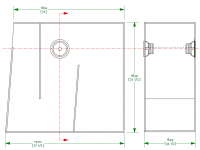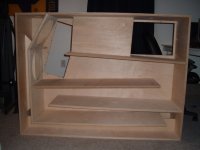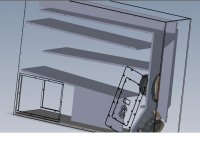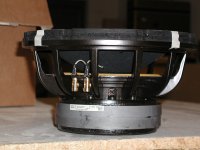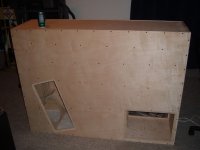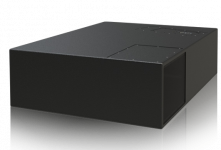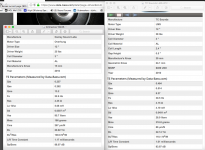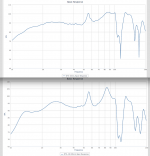... the "modern" TL theory that planet10 endorses ...
Covers off all of th eold TLs (and shows how they can be improved) and Voigt pipes as well as expanding valid TLs into a much larger design space (including the ML-TL subset you make a poke at).
It allows one to model a TL and get pretty good results with the first build as opposed to classic design when 10 or more builds were needed to get something half-***.
dave
Does a Voigt pipe or TL have a driver impedance bump lower in frequency compared to Fs as a result of the entrained air load on the cone?
Yes. Any TL (which includes Voigt pipes) have a double-humped impedance curve. The magnitude of the bump is affected by the amount of damping fill, if the line is damped until aperiodic the impedance bumps can (mostly) disappear.
dave
Steven,1)I haven't been able to see detailed plans for the "pipe" design...Does it need to have baffles like a standard TL enclosure?
2)Also, does the pipe have to be straight, or can it have curves/"Us" in it? I am asking because one picture that I saw was clearly about 12' tall and this has to fit under an 8' ceiling and fit through a normal inside door (30").
3)I almost forgot, most pipe designs use 2 drivers, is that part of that style of enclosure, or can you use a single driver?
1) Not sure which "pipe" design you refer to.
2) The first "T" in TQWP (Pipe) or TQWT(Tube) stands for "Tapered".
Paul Voigt's 1930's transmission lines had tapered (expanding) sections at the exit end, so designs with that direction of expansion are often referred to as a "Voigt pipe".
The "pipe" or "tube" or "transmission line" can be straight, or have one or more bends/curves/folds/"U" turns.
A 16 Hz wavelength is 70.6' feet, 1/4 wave length of that is 17.6".
At least three sections (divisions of 17.6") would be required to stand (and allow tipping room) a 16Hz transmission line under an 8' ceiling.
3)One or more drivers can be used. Many of the 2 driver enclosure plans are "full range", the second driver (not pointed "forward") is used primarily for low end contribution to "keep up" with the high frequency output.
Art
Last edited:
1/4 wave length of that is 17.6"
I believe intention was to say 17.5 feet. A heavy taper to shorten this might be of benefit.
dave
A push-push pair in a TL playing low and loud might be appropriate, such as an adaptation of your dual B-139 with a single fold, using a pair of LAB 12 or similar modern driver with 25.4 mm linear p-p excursion or more. A Neo magnet driver set would save weight. +1 on tipping clearance.
Last edited:
Dave,I believe intention was to say 17.5 feet. A heavy taper to shorten this might be of benefit.
Messed up, (",') .
What I intended to impart was all in feet:
A 16 Hz wavelength is 70.6 feet long, 1/4 wave length of that is 17.6 foot long.
A line would require at least three sections (divisions of the 17.6 foot path length) stand a 16Hz transmission line under an 8' ceiling.
How can a "heavy taper.. shorten" a 1/4 wave path length?
Art
How can a "heavy taper.. shorten" a 1/4 wave path length?
a line that tapers such that the open end is smaller than the closed end needs to be shorter to maintain the same quarter-wave frequency than a straight line, a line that tapers such that open end is larger than the closed end needs to be longer.
That a taper as 1st descibed will have a lower quarter wave resonance than a straight line of the same length was, i believe, the impirical data that led early TL builders to suggest that the damping slowed down the speed of sound (something that has since been refuted).
dave
A push-push pair in a TL playing low and loud might be appropriate, such as an adaptation of your dual B-139 with a single fold, using a pair of LAB 12
Using MJK tables and a 10:1 line to keep it short. This is a 1st approximation of a line as so specified… one is going to have to hope for minimum 36” door openings. Necessary bracing not shown, but room included for it.
dave
Attachments
After many suggestions and searching...
From what I have read and what people have suggested, given the limitations of size and also the requirements of the enclosure, I have decided that a ML-TL design is probably the best computerize (and hopefully it is not a big computerize). I am going to model the build after the Danley DTS10 DTS10 | Danley Sounds Labs | Danley Sound Labs, Inc. . I know that is about a 9 year old design, but with the right drivers (12" with a lot of excursion) since the don't make the original driver that was in those in the beginning ( 2 - 12" Eminence 12245s), I need a modern comparable pair of drivers that aren't a million dollars. I have not been able to find the T/S spec on that speaker yet to make a comparison to something made today, but maybe someone here will have suggestions. The wattage will be around 1000watts, based on those used back then. That might have to be changed, but the specs of the DTS10 goes down to 10 Hz at ~90dB and rises to about 132 dB in the 80 Hz - 100 Hz range. The SPL is large IIRC. This is not my area of expertise, so the learning curve is steep as this is for a single design that will be repeated, if it does the intended job. Thank you, Steven
From what I have read and what people have suggested, given the limitations of size and also the requirements of the enclosure, I have decided that a ML-TL design is probably the best computerize (and hopefully it is not a big computerize). I am going to model the build after the Danley DTS10 DTS10 | Danley Sounds Labs | Danley Sound Labs, Inc. . I know that is about a 9 year old design, but with the right drivers (12" with a lot of excursion) since the don't make the original driver that was in those in the beginning ( 2 - 12" Eminence 12245s), I need a modern comparable pair of drivers that aren't a million dollars. I have not been able to find the T/S spec on that speaker yet to make a comparison to something made today, but maybe someone here will have suggestions. The wattage will be around 1000watts, based on those used back then. That might have to be changed, but the specs of the DTS10 goes down to 10 Hz at ~90dB and rises to about 132 dB in the 80 Hz - 100 Hz range. The SPL is large IIRC. This is not my area of expertise, so the learning curve is steep as this is for a single design that will be repeated, if it does the intended job. Thank you, Steven
Attachments
Steven,I am going to model the build after the Danley DTS10. I know that is about a 9 year old design, but with the right drivers (12" with a lot of excursion) since the don't make the original driver that was in those in the beginning ( 2 - 12" Eminence 12245s), I need a modern comparable pair of drivers that aren't a million dollars.
Josh Ricci (Data Bass link in post #6) tested the DTS10 with both the stock Eminence drivers and the TC Sounds LMS-R 12". He provided the TS parameters for both, the LMS-R 12" was capable of more output due to it's increased Xmax over the Eminence, though not as much as the difference would suggest.
The LMS-R has more motor strength (Bl), but a higher Fs, resulting in more SPL at the Fc (horn Cut-off Frequency) of 14-15 Hz, but a steeper drop off below.
Frequency response and TS parameters as measured by Josh Ricci below.
Given the large variations of many of the TS parameters between the two drivers did not result in large frequency response variations (compared to what will be experienced in rooms!), there is quite a bit of latitude in finding suitable replacement drivers.
Keep Bl in mind- much below around 20Tm the very low frequency performance may suffer.
Cheers,
Art
Attachments
Last edited:
Just for you to see it .....
http://www.troelsgravesen.dk/FUSION/12N630.pdf
http://www.troelsgravesen.dk/DTQWT-12_files/2512.pdf
Maybe they admit little power for you
That project will have tremendous sub-bass ! : eek:
http://www.troelsgravesen.dk/FUSION/12N630.pdf
http://www.troelsgravesen.dk/DTQWT-12_files/2512.pdf
Maybe they admit little power for you
That project will have tremendous sub-bass ! : eek:
Thank you for the T/S and Chart Info.
Hi Art and All, Thank you for the T/S info. and the chart info on the Eminence 122345. I couldn't find any reference for the driver and I assumed that because it is ~9 years old that it is well out of production and because this is so out of my forte, I guess I didn't know the right places to look.
Sorry to have mistakenly put (ML-TL) as I know that is what I was originally searching and ended up at the AVSForum site, post17386336 which detailed the DTS10 and looking at it and reading the post, it seemed like it would be something that would work. Sorry for calling the wrong name and not calling it a "Tapped Horn".
The ONLY reason I started all of this is because a friend of mine in Australia, Owen Jones, who built a virtual theater pipe organ (VTPO), said how much of a difference the TL speaker ("Dearth Varder" [bottom of the page]) made the organ sound, calling it, wall-shaking and causing chest pressure like a pipe organ does in the low frequencies. I had been looking at various ideas and even bought the set of plans for the "House Wrecker" speaker, using 4, 15" drivers.
Like I said earlier, I am like a fish out of water here, with a task that requires me to get into all of this at a level all of you have and took years to get to and I only have a short time and only need a single design that will work and then I can make duplicates of that design as called for. One area of my research was watching YouTube "How-To" videos and that got me into complex math using MS Mathematics and CAD using Sketchup. Sketchup, actually turned out to be a useful program and the MS program does make some calculations easier, in that it formats them properly, but I got into the T//S parameters (which I had never heard of before) and then basing the enclosure on that of a given driver.
I can't begin to tell you, when you are used to dealing with acoustic instruments and then go to extremely high-end audio, it is a huge jump, at least for me. A pipe organ is basically a bunch of whistles, driven by air and based on their shape and makeup create sound of differing types. I completely understand that and could build you one from start to finish (less the metal pipe-making that requires equipment that I do not have and years of practice.
By no means am I casting aspersions, but I am just saying that this is so foreign to me. With the advent of "good" digital sampling techniques of pipe organs, it is now possible to get something in places where a sizable pipe organ wouldn't fit and at a cost MANY times less than the equivalent pipe organ, not to mention the appropriate room to put it in (a large stone [reverberant] building). I just want something economical because I am on a limited income and that TL design, seemed to be the "ticket", until I started looking into it and the more I looked into it, the more and more complex it all became. I know that Owen spent $175.00 on his driver and it looked similar to the DA driver I was told would work with the enclosure I was going to originally build. I can afford a few sheets of 1" MDF, a driver in that range, although he one I was told about was only $100.00, but that could simply be the difference of cost between things here and things in Australia. The amp was $300.00ish dollars, which I would have had to save for, but for relatively a small amount, I could cover the frequency range I needed in the way I needed. I am not looking for what all of the kids today put into their cars and "bump" while riding around. I need something that will handle clear, very low frequencies for extended notes, regardless pf sound level. I could provide links to recordings of what I am talking about if it would help. This is just very involved, to theoretically be such a simple task. I just want something that will work, fit with the parameters I mentioned and isn't a unit that costs more than my mortgage. I hope you can understand here I am coming from. Thank you, Steven
Hi Art and All, Thank you for the T/S info. and the chart info on the Eminence 122345. I couldn't find any reference for the driver and I assumed that because it is ~9 years old that it is well out of production and because this is so out of my forte, I guess I didn't know the right places to look.
Sorry to have mistakenly put (ML-TL) as I know that is what I was originally searching and ended up at the AVSForum site, post17386336 which detailed the DTS10 and looking at it and reading the post, it seemed like it would be something that would work. Sorry for calling the wrong name and not calling it a "Tapped Horn".
The ONLY reason I started all of this is because a friend of mine in Australia, Owen Jones, who built a virtual theater pipe organ (VTPO), said how much of a difference the TL speaker ("Dearth Varder" [bottom of the page]) made the organ sound, calling it, wall-shaking and causing chest pressure like a pipe organ does in the low frequencies. I had been looking at various ideas and even bought the set of plans for the "House Wrecker" speaker, using 4, 15" drivers.
Like I said earlier, I am like a fish out of water here, with a task that requires me to get into all of this at a level all of you have and took years to get to and I only have a short time and only need a single design that will work and then I can make duplicates of that design as called for. One area of my research was watching YouTube "How-To" videos and that got me into complex math using MS Mathematics and CAD using Sketchup. Sketchup, actually turned out to be a useful program and the MS program does make some calculations easier, in that it formats them properly, but I got into the T//S parameters (which I had never heard of before) and then basing the enclosure on that of a given driver.
I can't begin to tell you, when you are used to dealing with acoustic instruments and then go to extremely high-end audio, it is a huge jump, at least for me. A pipe organ is basically a bunch of whistles, driven by air and based on their shape and makeup create sound of differing types. I completely understand that and could build you one from start to finish (less the metal pipe-making that requires equipment that I do not have and years of practice.
By no means am I casting aspersions, but I am just saying that this is so foreign to me. With the advent of "good" digital sampling techniques of pipe organs, it is now possible to get something in places where a sizable pipe organ wouldn't fit and at a cost MANY times less than the equivalent pipe organ, not to mention the appropriate room to put it in (a large stone [reverberant] building). I just want something economical because I am on a limited income and that TL design, seemed to be the "ticket", until I started looking into it and the more I looked into it, the more and more complex it all became. I know that Owen spent $175.00 on his driver and it looked similar to the DA driver I was told would work with the enclosure I was going to originally build. I can afford a few sheets of 1" MDF, a driver in that range, although he one I was told about was only $100.00, but that could simply be the difference of cost between things here and things in Australia. The amp was $300.00ish dollars, which I would have had to save for, but for relatively a small amount, I could cover the frequency range I needed in the way I needed. I am not looking for what all of the kids today put into their cars and "bump" while riding around. I need something that will handle clear, very low frequencies for extended notes, regardless pf sound level. I could provide links to recordings of what I am talking about if it would help. This is just very involved, to theoretically be such a simple task. I just want something that will work, fit with the parameters I mentioned and isn't a unit that costs more than my mortgage. I hope you can understand here I am coming from. Thank you, Steven
I believe that Eminence 12" was replaced with the LAB 12 driver, which is still in production. You will need an appropriate pro sound amplifier, and the used market is your friend here. Hopefully the experts will keep contributing to this worthy cause. The 16 Hz target is in the home theater realm though, so getting the right rig will take some wrangling to keep the cost down.
Please use no-void plywood instead of mdf. Lighter, stiffer, much less toxic sawdust. Does not have to be Baltic birch. Don't look for it at Homer's, go to Frere's and ask for it. They know from plywood.
Please use no-void plywood instead of mdf. Lighter, stiffer, much less toxic sawdust. Does not have to be Baltic birch. Don't look for it at Homer's, go to Frere's and ask for it. They know from plywood.
Last edited:
Please use no-void plywood instead of mdf.
I would normally NEVER use MDF for anything, but I have seen it used for speaker enclosures, almost exclusively (at least in the "everyday market). That, and I was told to use 1" MDF with this build is why I mentioned it. Even finding 1" MDF had to be special ordered if I wanted it. I will look into 1" no-void "one-good-side" plywood as I am sure, I cannot afford 13ply Baltic Birch for this...especially since it will use a few sheets. I am just tearing my hair out. Everyone makes subs that go down the 20 Hz, but they are made for these kids that want to "bump" in their cars. That is definitely not what I want (or need). Little did I know, how much difference 4 Hz would make, especially in enclosures. It is a 2-edged sword, I know what a pipe organ sounds and feels like and want/need to reproduce that, on the other hand, I need to do it on a tight budget. Even finding used (which I don't mind), as I have a 1974 set of speakers that came with an analog Rodgers organ I bought that has their P1 which has a 30" cone in a BIG box. I guess, I though things would have evolved more in nearly 45 years.
Steven,Hi Art and All, Thank you for the T/S info. and the chart info on the Eminence 122345. Sorry for calling the wrong name and not calling it a "Tapped Horn".
I just want something that will work, fit with the parameters I mentioned and isn't a unit that costs more than my mortgage. I hope you can understand here I am coming from. Thank you, Steven
I understand where you are coming from.
If you have any more questions regarding the DTS-10, ask away.
By the way, you could build the cabinet and use only one driver to start with a cover over the second driver cut out, then later add a second driver if you still want more output.
The second driver and power will add 6 dB output, which sounds more than twice as loud to your hearing at 16 Hz. The DTS-10 with one modern driver properly powered will be a lot (as in more than twice as loud) louder at 16 Hz than the 60 watt EV 30W used in the 1974 cabinet that came with an analog Rodgers.
As phivates mentioned, use decent plywood rather than MDF, the goal is a stiff enclosure, not one that weighs a half-ton. You can save up for plywood, you don't want to pay for a back injury for the rest of your life.
Cheers,
Art
Last edited:
- Status
- This old topic is closed. If you want to reopen this topic, contact a moderator using the "Report Post" button.
- Home
- Loudspeakers
- Subwoofers
- 16 Hz 18" TL enclosure design
